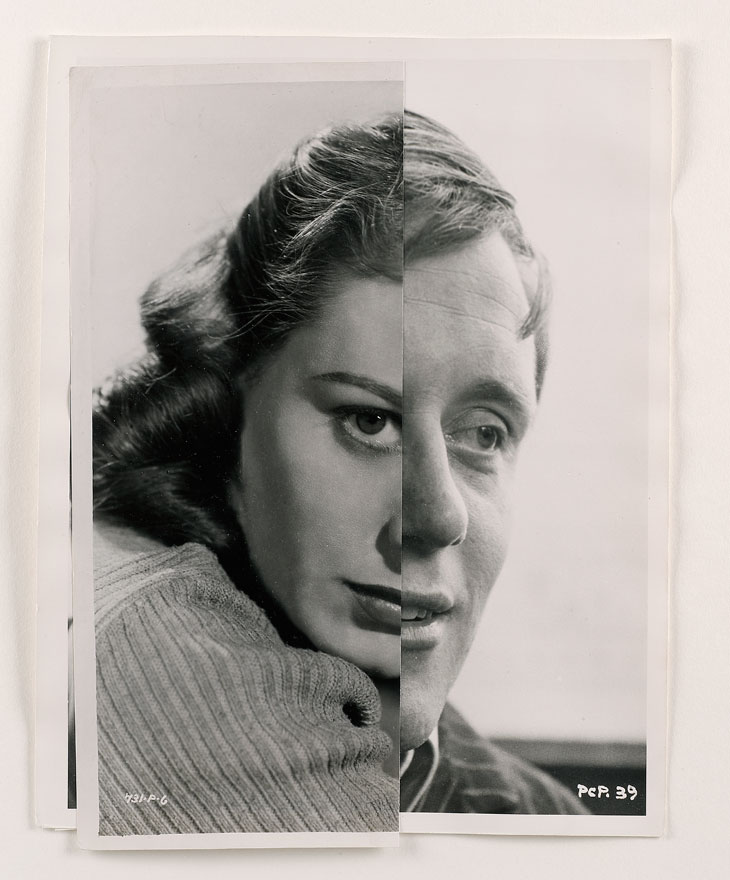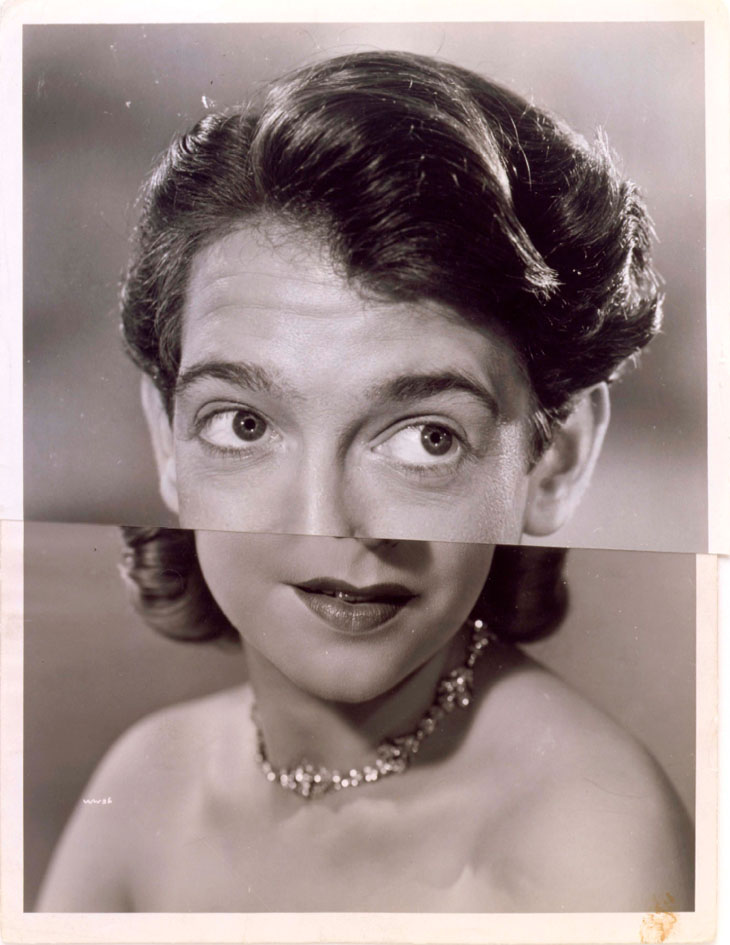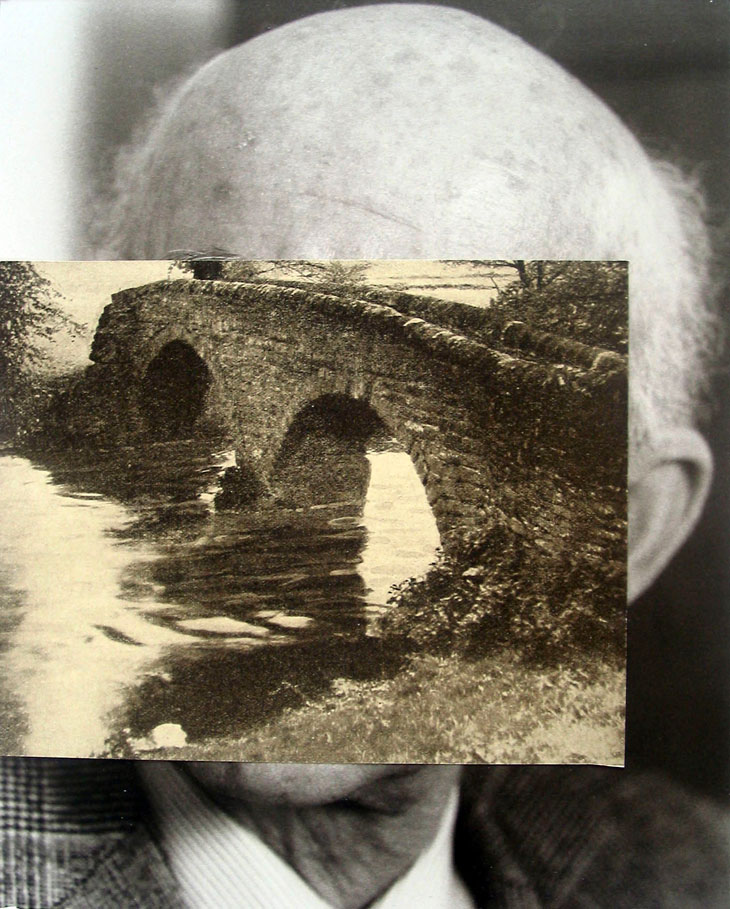Tom Pope has been short-listed for the Saatchi online art graduates Channel 4 New Sensations Prize and has been artist in residence at the Swansea Metropolitan University and in Jersey back in 2015. I really like Pope’s unusual work, challenging normalities of photography. Tom Pope is a young artist with a promising future.
Tom’s interest in photography lies in its recording qualities and in particular how it can visually document his performances. Clearly attracted to the absurd, he sources his background landscape with great care, but then leaves everything else to chance and possibility. Unable to know what the picture looks like as he takes it, he leaves room for the viewer to bring their own narrative to the photograph. He does not conform to conventions of photography as he takes self-portraits using a shutter release cable, leaving the wire in the image, not photoshopping it out.

Troika Editions Contemporary Photography website asked Pope a few questions in an interview, here are the ones that stuck out most to me:
When are you at your happiest?
While embracing the effects of gravity.
What is your most treasured possession?
My mind.
What really winds you up?
Technology.
What do you do when not working?
I try to escape from my head by travelling to a city or country I have never been to before. It has the added bonus of offering a new experience and inspiration to my work when I get back home.
Where do you get your inspiration from?
Books, films, music, cultures, history, science, mirrors, people, everything, nothing,
How you would you like to be remembered?
The suit-wearing absurdist that made art fun.


Born in Bristol, UK, 1986 Tom Pope’s artistic practice is primarily based within performed photography. Pope’s playful approach rein-acts situations and performed gestures of social interaction. Many of Pope’s works combine performance, photography and moving image.
The most-part of his may seem improvised and taken in a rather relaxed way to seem as though he has just clicked the shutter button. He rarely expands on his work min post-production. The images depict the excitement and often absurdity that develops through his connections with members of the public who have been active participants within the making process.
Before completing his series of work in Jersey, Pope stated: ‘The work I intend to carry out in Jersey will explore notions of play and how we conduct ourselves in public. Gathering inspiration from the Société Jersiaise Photo Archive and collaborating with the Jersey community, performances and situations will be initiated where the act of taking and making photographs becomes a social event.’
Here are some of the works from his commissioned work in Jersey, entitled ‘I am not Tom Pope, You Are All Tom Pope’:


Image Analysis

This is an image made my Tom Pope and is an excellent example of his spontaneity when taking an image. He breaks the norms of self-portrait by including motion and blur in his photos – most of the time seen to be a determiner of how bad a photo is, he does not look directly at the camera and includes the shutter release wire in each photo of himself to contextualise his work. It is obscure and very abstract – it requires some thought but this is what I like about his work. I have also had the pleasure of working Pope when he was over in Jersey for the artist in residence scheme. He held a workshop and made it as fun as he could and left options open for freedom in how we took out images.
What is actually in the photo?
This is a photo that follows the norms of Pope’s other works, in which he positions himself, most of the time, in the air, as though he is levitating in mid-air – however, as we know, he has jumped and used a quick shutter speed to capture his movement sharply. He has photographed himself in a public location to encourage the interaction of public within his images and this adds a certain novelty and humour to the image as we see an old man look at Pope in confusion as he makes his way back down to ground. Also, it is difficult to tell whether Pope adds any after effects to his images due to the quite bland and often soft colours. There is no vibrancy to the colours and no sharpness to the backgrounds – encouraging the thought that he leaves his images in their raw form. I admire this because it adds to the effect that his images are very spontaneous and he essentially hopes for the best most of the time, considering he can’t actually see what he is photographing – therefore preparation and set up in the first instance on site is vital. This idea that he leaves all hs images in their raw form with very little post prediction reduces the need to put aside the images that may have turned out as you didn’t want and prioritise the more successful images to add effects to. It is more likely that all his images will be of worth to him, especially due to the heavy focus he has on breaking conventions – so over exposure or cropping of his head when taking the photo could actually result in a more interesting outcome.
What could it be about?
It is difficult to derive meaning from Pope’s work due to its such obscure nature. Pope’s meanings behind his photography and what he wishes to achieve from his own work is the interaction between himself and his environment – whether that be a landscape admired by the nation, such as the River Severn or whether it be the interaction between himself and the people around him.
Perhaps he is trying to draw the attention to his surroundings when he photographs himself immersed in them – the landscapes and countryside and the people he includes in his images. Perhaps he wishes for them to be acknowledged as more than just strangers and people who actually influence others’ lives just through a split second nor snap shot – because that is essentially what a photo is – a snap shot and being able to photograph this unknowingly pointless things creates a documentation of something that becomes of much more worth as it has been captured digitally – to live in history. There may not ever be a bad image – they may all be good but you just have to look at it a little deeper to realise the worth – something Tom Pope seems very keen in advocating due to his inclusion of his surroundings.
Judging the photo
Whether the photo is good, is always difficult to tell because someone’s deception of something ‘good’ or whether its ‘brilliant’ can be completely different to someone else’s view. I find it very hard to judge a photo because I feel like no photo can be judged without the chance of misinterpreting the message the artist wishes to get across. I personally really like this photo send all of Pope’s work because of is complete weirdness – it is very out of the ordinary but that is what you need to so in order to make a name for yourself, essentially. I like art and photography that can make me question what it is or what it means etc. I don’t want the answer to be right in front of my face or for the actual content of the photo to be explicitly directed to the audience. It is vital for you to look at it in different perspectives in order to build a range of thoughts about a photo. This is what I believe Pope’s photography does – therefore, in my eyes making it a good photo because it provokes the thoughts of viewers and doesn’t provide you the answer – therefore making it boring. The obscurity of Pope’s work makes it interesting. This adds to the idea that no image is bad or should be hidden away due to worry that it may get the wrong reaction from audiences because all images have scope for the thoughts of the audience to complete what the photographer may not actually know himself.
Theorising the photo
All photography is an art form and possesses its own intended message shown through different features. I would say that Pope’s work shows more of straight photography or contemporary photography more so than any other theories. This is due to the message it intends to get across as the artist wishes to get his audience to view the world in a new way from new perspective – that is why he has chosen to photograph himself in this weird and wonderful. In straight photography, these photographers strove to make pictures that were ‘photographic’ rather than ‘painterly’, they did not want to treat photography as a kind of monochrome painting. I believe Pope wishes to show photography as a new medium and make people see it as a way to show life and how people react to different things that on around them – becoming contemporary due to this message. It’s a thought that doesn’t really have any relevance, but, for example, if Tom Pope put his work into an archive that holds photos that relate to the history of the place it is located, people would probably turn their noses up at it as something that breaks boundaries according to what photography should be where the subject is looking at the camera or the environment is the focal point of the image.









 Here are the links that I used to research Luigi Ghirri.
Here are the links that I used to research Luigi Ghirri.  LUIGI GHIRRI
LUIGI GHIRRI 









 1933. The painting is very ghostly looking. The name Crucifixion suits the artwork because It looks like a human holding up their hands while standing on a platform. Here are more of Bacon’s paintings. I personally believe that Francis Bacon and Jonny Briggs are very similar in the way they work and how they use their past as an influence for their art. Briggs uses his photography as a way to get back lost time with his parents. He sees it as a way to improve the relationships within his family. Bacon uses his art to express his troubled childhood as well. He is full of Anxiety and depression and uses his art as a demonstration of what he is feeling.
1933. The painting is very ghostly looking. The name Crucifixion suits the artwork because It looks like a human holding up their hands while standing on a platform. Here are more of Bacon’s paintings. I personally believe that Francis Bacon and Jonny Briggs are very similar in the way they work and how they use their past as an influence for their art. Briggs uses his photography as a way to get back lost time with his parents. He sees it as a way to improve the relationships within his family. Bacon uses his art to express his troubled childhood as well. He is full of Anxiety and depression and uses his art as a demonstration of what he is feeling.










































































